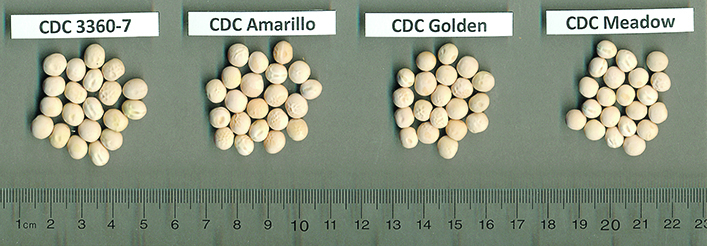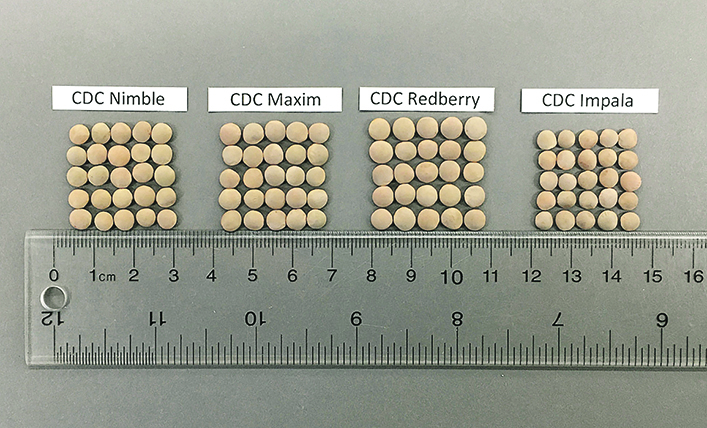The lack of soil moisture that persists across the Prairies this year will not likely cause farmers to shy away from new pulse varieties.
That’s according to Sask Pulse seed program manager Laurie Friesen. She says it’s unlikely that lack of soil moisture will sway growers away from the new releases.
She said avoiding new varieties because of current moisture conditions may not even enter the equation.
“It’s going to bother farmers with any crop, whether it’s an older variety or a new release. It’s doesn’t change whether or not they’re willing to try new varieties. It won’t affect the success or failure of any new variety. Dry conditions affect the overall crop year.”
This brief summary of the 2021 Sask Pulse Variety Update provides data on the five new releases.
Lentils
CDC Lima — It is the highest yielding large green Clearfield variety. In eight years of testing in co-op and regional trials, it yielded 10 percent higher in the brown and dark brown soil zones and 18 percent higher in the black and dark grey zones compared to CDC Impower.

In four years of head-to-head testing in the lentil regional variety trials (2017 – 2020) CDC Lima yielded 16 percent higher in the brown and dark brown soil zones and 13 percent higher in the black and dark grey zones compared to CDC Impower. Compared to non-Clearfield CDC Greenstar, CDC Lima yielded four percent lower in the brown and dark brown soil zones but six percent higher in the black and dark gray zones.
Yellow peas
CDC Canary — This is an early maturing yellow, semi-leafless field pea variety. In eight years of testing, it yielded 98 percent of the check CDC Amarillo in both the north and south geographies. It has very good standability as well as a round seed shape and good resistance to seed coat breakage. It is a good choice anywhere that early maturity is important.

CDC Lewochko — In seven years testing in the co-op and regional trials, CDC Lewochko yielded 102 percent of the check variety in the south and 103 percent in the north. It has very good lodging resistance and the highest protein of the yellow pea varieties at +0.7 percent versus CDC Amarillo. There may be limited seed starting in 2021.

Green peas
CDC Forest— A green cotyledon, semi-leafless field pea variety. In eight years of co-op and regional trials, CDC Forest was the top yielding green pea in both the north and south geographies. It yielded 100 percent of the yellow pea check CDC Amarillo in the south and 101 percent in the north. It has good lodging resistance, medium maturity, medium seed size, good resistance to seed coat breakage. Protein is similar to CDC Amarillo. Although good for bleaching, some growers indicate it is not as good as Raezer for this trait.

In the pipeline
There are a number of new CDC varieties in the variety release program, currently in seed production for future distribution. These new pulse varieties will be available to growers about four or five years after release to select seed growers:
- Two new yellow pea varieties in 2021
- Two new small red lentil varieties in 2019 (CDC Nimble and CDC Simmie)
- One new large green lentil variety in 2021 (CDC Grimm)
- One new small green lentil variety in 2021 (CDC Jimini)
- Four new kabuli chickpeas: CDC Lancer (2019), CDC Orkney (2020) and two in 2021
- Two new desi chickpea varieties in 2021

In the report Friesen says public and private breeding partnerships and will address important production concerns:
- Resistance to root rot in peas and lentils
- New herbicide traits in lentils
- Increasing the adaptability of chickpeas, fababeans, and dry beans to current and expanded production areas in Saskatchewan.
Drought tolerance
Saskatchewan, like the rest of the Canadian Prairies, can be prone to very dry condition from time to time, yet there is no mention of drought tolerance in any of the five new releases.
Friesen says that doesn’t mean researchers aren’t looking for it.
“Drought tolerance isn’t one of the key targets that are measured. It doesn’t mean they (breeders) aren’t looking at genetics with that tolerance.”
Read Also

Huge Black Sea flax crop to provide stiff competition
Russia and Kazakhstan harvested huge flax crops and will be providing stiff competition in China and the EU.


















